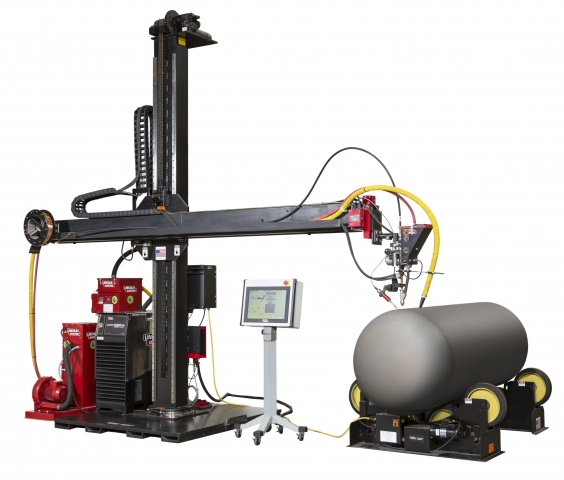by Scott Stanley
Considerations for purchasing the right system
If you are a manufacturer of pressure vessels, pilings, or other large pieces like wheel rims, you probably have some welding manipulators in your welding facility already.

Or maybe you’re using a combination of submerged arc tractors for long seam welds and a homemade setup combined with turning rolls for welding circumferentially. Either way, an investment in a manipulator upgrade, or even a complete manipulator system, can quickly pay for itself through productivity and quality improvements.
When purchasing a standard column and boom manipulator, it is important to begin with a thorough understanding of all the likely welding and production requirements. These factors will determine which options make the most sense for your welding facility.
- Here are some things to consider when welding a pressure vessel:
Will the manipulator be stationary? Will it be responsible for both long seam welds and circumferential welds? Will the base rotate to handle multiple welding stations? - Will the long seam of the pressure vessel be longer than the stroke of the manipulator? In that case, a travel carriage and rail setup suitable for welding on the move will be required. This will allow the manipulator to weld the outside long seam smoothly and with consistent speed, while moving on a track running the length of the pressure vessel.
- For welding the interior of the long seam, will the manipulator be long enough to weld the required length while booming out? To have control over the travel speed of the boom, ensure you have a Variable Frequency Drive (VFD). Linear bearings are also a good idea to ensure smooth travel and repeatable positioning of the welding head.
- Will the welding head be required to handle a future upgrade to tandem welding or a hopper mounted flux recovery system? If so, the capacity of the manipulator will need to be taken into account.
Once you’ve selected the manipulator, there are other options available in a fully functional welding package.
Welding power source
- Transformer or inverter based DC only power sources provide cost effective welding solutions, but inverter based systems offer many more benefits, such as increased welding deposition rates, power savings, and with some systems, cloud based production monitoring networks.
How will the welding head be adjusted?
- A 180° pivot block allows the welding head to be changed easily from the long seam to circumferential seam orientation.
- Manual welding slides are durable and cost effective, but require the operator to rotate adjustment knobs for weld placement.
- Powered cross slides allow the operator to make fine adjustments with a control pendant.
- Powered cross slides combined with tactile seam tracking can automatically ensure the crucial first welding pass is completed without fine adjustment from the operator.
- Laser seam tracking is the most expensive option, but when using root path memorization on the first pass, it allows seam tracking for subsequent passes, all the way out of the joint.
How will the system be controlled?
- An integrated digital control system with Human Machine Interface (HMI) screen can provide a single control point of all variables, and removes the clutter of multiple manipulator control boxes.
- Depending on the size of the part, the HMI can be installed at the end of the welding boom, or at ground level. If the HMI is at ground level on a large part, an integrated welding camera should be used so that the operator has a safe and easy view of the weld area.
Flux recovery system selection
- There are many hopper mounted flux recovery systems available. However, a closed loop flux recovery system with vacuum and pressure feed offers the greatest flexibility and power, and the lowest load on the welding head. These systems also allow the boom to access smaller inside diameter pressure vessels when welding long seams inside the vessel.
Purchasing a welding manipulator is not just about the manipulator. This is an integrated system, and success or failure will depend on all the parts being selected properly, and working together. Choose wisely. SMT
Scott Stanley is national marketing manager with Lincoln Electric Co. of Canada.
[email protected]
